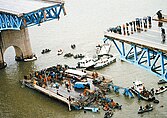- The following is an archived discussion of the DYK nomination of the article below. Please do not modify this page. Subsequent comments should be made on the appropriate discussion page (such as this nomination's talk page, the article's talk page or Wikipedia talk:Did you know), unless there is consensus to re-open the discussion at this page. No further edits should be made to this page.
The result was: promoted by Cielquiparle (talk) 23:49, 8 March 2023 (UTC)
Seongsu Bridge Disaster

Seongsu Bridge collapse
- ... that after the Seongsu Bridge collapsed (pictured) in Seoul, radiographic testing found that 110 of the 111 connections in the bridge were filled with defects? Source: "The direct cause of the collapse was poor welding of vertical members, which were the core elements to connect suspension truss to anchor truss. After radiographic investigation tests, among 111 connections of the bridge, 110 were identified with defects. Compared to the 18 mm thickness of vertical member, the actual depth of penetration was only 8 mm, and the available depth of penetration of some was merely 2 mm." (174, Kim Yong-kyun, Disaster Risk Management in the Republic of Korea (2017), https://archive.org/details/disasterriskmana0000kimy/page/174/)
- ALT1: ... that the Sampoong Department Store collapsed 9 months after President Kim Young-sam promised to minimize all construction risks in response to the Seongsu Bridge disaster (pictured) in Seoul? Source: "The next day, on October 24, the president made a special public statement through a national telecast. The statement contained several important issues...the government would like to promise to take all kinds of measures to minimize all risks existing in Korea...In spite of efforts to prevent large-scale accidents through activities at the National Assembly and the government, after the collapse of Seongsu bridge, another large-scale disaster occurred when the Sampoong Department Store collapsed on June 29, 1995." (157-8, Kim Yong-kyun, Disaster Risk Management in the Republic of Korea (2017), https://archive.org/details/disasterriskmana0000kimy/page/174/)
- ALT2: ... that repairs for the Seongsu Bridge in Seoul were scheduled the day before the Seongsu Bridge collapsed (pictured), but were postponed due to bad weather? Source: "City officials said repairs on the bridge had been scheduled for Thursday evening but were postponed because of bad weather. The central span was not due for repair, however, they said." https://www.nytimes.com/1994/10/22/world/32-reported-dead-as-bridge-collapses-in-seoul.html
- ALT3: ... that the Seoul Metropolitan Government planned to reopen the Seongsu Bridge to traffic 3 months after it collapsed (pictured), but stopped after public outcry? Source: "After the accident was taken care of, Seoul City announced to reopen traffic after three months by repairing the intact parts but citizens were against the idea. Therefore, the policy was retracted and it was decided to newly construct the bridge." (157-8, Kim Yong-kyun, Disaster Risk Management in the Republic of Korea (2017), https://archive.org/details/disasterriskmana0000kimy/page/174/)
- Reviewed:
Created by Freedom4U (talk). Self-nominated at 05:54, 20 February 2023 (UTC). Post-promotion hook changes for this nom will be logged at Template talk:Did you know nominations/Seongsu Bridge Disaster; consider watching this nomination, if it is successful, until the hook appears on the Main Page.
| General: Article is new enough and long enough
|
|
|
| Policy: Article is sourced, neutral, and free of copyright problems
|
|
|
| Hook: Hook has been verified by provided inline citation
|
|
|
| Image: Image is freely licensed, used in the article, and clear at 100px.
|
|
|
Overall:  @Freedom4U: Good article. AGF on Korean sources. Onegreatjoke (talk) 20:43, 20 February 2023 (UTC)
@Freedom4U: Good article. AGF on Korean sources. Onegreatjoke (talk) 20:43, 20 February 2023 (UTC)
![]() @Freedom4U: Good article. AGF on Korean sources. Onegreatjoke (talk) 20:43, 20 February 2023 (UTC)
@Freedom4U: Good article. AGF on Korean sources. Onegreatjoke (talk) 20:43, 20 February 2023 (UTC)
